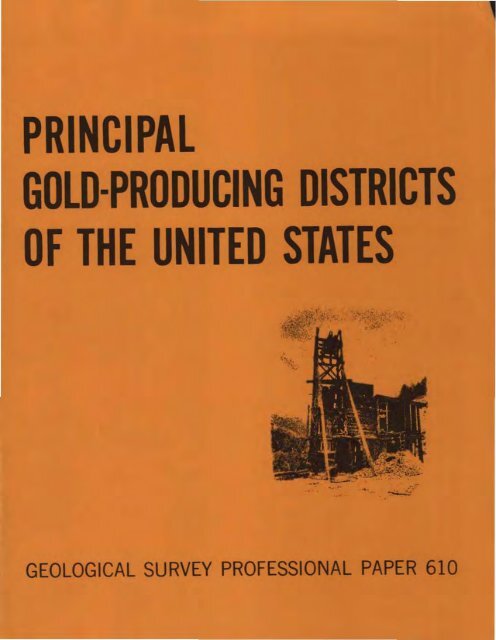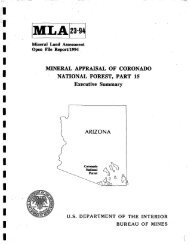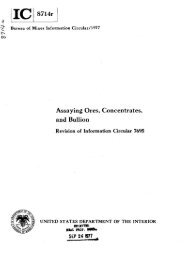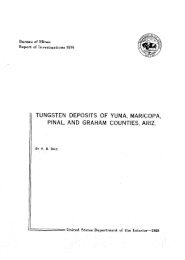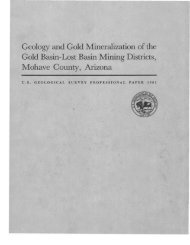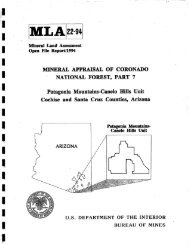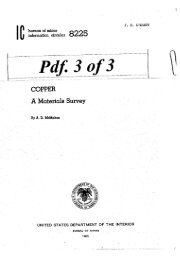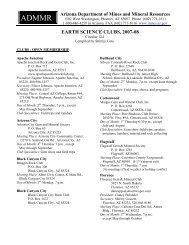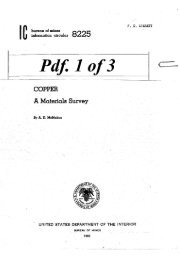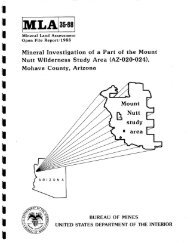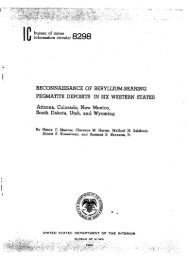here - State of Arizona Department of Mines and Mineral Resources
here - State of Arizona Department of Mines and Mineral Resources
here - State of Arizona Department of Mines and Mineral Resources
You also want an ePaper? Increase the reach of your titles
YUMPU automatically turns print PDFs into web optimized ePapers that Google loves.
PRINCIPAL<br />
GOLD-PRODUCING D CIS<br />
OF THE UNITED S1 ES<br />
GEOLOGICAL SURVEY PROFESSIONAL PAPER 610
Principal<br />
Gold-Producing Districts<br />
<strong>of</strong> the United <strong>State</strong>s<br />
By A. H. KOSCHMANN <strong>and</strong> M. H. BERGENDAHL<br />
GEOLOGICAL SURVEY PROFESSIONAL PAPER 610<br />
A description <strong>of</strong> the geology, mining history,<br />
<strong>and</strong> production <strong>of</strong> the major gold-mining<br />
districts in21 <strong>State</strong>s<br />
UNITED STATES GOVERNMENT PRINTING OFFICE, WASHINGTON 1968
UNITED STATES DEPARTMENT OF THE INTERIOR<br />
JAMES G. WATT, Secretary<br />
GEOLOGICAL SURVEY<br />
Dallas L. Peck, Director<br />
Library <strong>of</strong> Congress Calalog-card No. GS 68-341<br />
First Printing 1968<br />
Second Printing 19SO<br />
Third Printing 1982<br />
For sale by the Superintendent <strong>of</strong> Documents. U.S. Government Printing Office<br />
Washington, D.C. 20402
Jlbstract _<br />
IntrodueQon _<br />
Scope <strong>and</strong> objecuves _<br />
Authorship <strong>and</strong> acknowledgments _<br />
Distribution <strong>of</strong> principal districts _<br />
Geologic relations _<br />
History <strong>of</strong> gold mining <strong>and</strong> trends in production_<br />
Jllabama _<br />
Cleburne County _<br />
Tallapoosa County _<br />
Jllaska _<br />
Cook Inlet-Susitna region _<br />
Copper River region _<br />
lCuskokwiro region _<br />
Northwestern Jllaska region _<br />
Seward Peninsula region _<br />
Southeastern Jllaska region -<br />
Southwestern Jllaska region _<br />
1{ukon region _<br />
Prince William Sound region _<br />
<strong>Arizona</strong> _<br />
Cochise County _<br />
Gila County _<br />
Greenlee County _<br />
!daricopa County _<br />
!dohave County _<br />
Pima County _<br />
Pinal County _<br />
Santa Cruz County _<br />
1{avapai County _<br />
1{uma County _<br />
California _<br />
Amador County _<br />
Butte County _<br />
Calaveras County _<br />
Del Norte County _<br />
EI Dorado County _<br />
Fresno County _<br />
Humboldt County _<br />
Imperial County _<br />
Inyo County _<br />
lCern County _<br />
Lassen County _<br />
Los Jlngeles County _<br />
Jdadera County _<br />
Jdariposa County _<br />
Jderced County _<br />
Jdodoc County _<br />
!dono County _<br />
Napa County _<br />
Nevada County _<br />
Placer County _<br />
Plumas County _<br />
Riverside County _<br />
Sacramento County _<br />
CONTENTS<br />
Pap California-Continued<br />
1 San Bernardino County _<br />
2 San Diego County _<br />
3 San Joaquin County _<br />
3 Shasta County _<br />
3 Sierra County _<br />
4 Siskiyou County _<br />
4 Stanislaus County _<br />
6 Trinity County _<br />
7 Tulare County _<br />
8 Tuolumne County _<br />
8 1:uba County _<br />
11 Colorado _<br />
13 Jldams County _<br />
14 Boulder County _<br />
16 Chaffee County _<br />
16 Clear Creek County _<br />
19 Custer County _<br />
23 Dolores County _<br />
23 Eagle County _<br />
31 Gilpin County _<br />
32 Gunnison County _<br />
35 Hinsdale County _<br />
37 Jefferson County _<br />
38 Lake COunty _<br />
39 La Plata County _<br />
40 lIineral County _<br />
42 Ouray County _<br />
43 Park County _<br />
odS Pitkin County _<br />
45 Rio Gr<strong>and</strong>e County _<br />
51 Routt County _<br />
53 Saguache County _<br />
58 San Juan County _<br />
58 San nligue1 County _<br />
59 Sunnnit County _<br />
60 Teller County _<br />
60 Georgia _<br />
61 Cherokee County _<br />
62 Lumpkin County _<br />
62 VVhite Count,y _<br />
62 Idaho _<br />
64 Jlda County _<br />
66 Bingham County _<br />
66 Blaine County _<br />
67 Boise County _<br />
67 Bonneville County _<br />
69 Camas County _<br />
69 Cassia, Jerome, <strong>and</strong> !dinidoka Counties _<br />
69 Clearwater County _<br />
70 Custer County _<br />
70 Elmore County _<br />
72 Gem County _<br />
73 Idaho County _<br />
74 Latah County _<br />
75 Lemhi County _<br />
III<br />
75<br />
76<br />
77<br />
77<br />
79<br />
80<br />
81<br />
81<br />
82<br />
82<br />
84<br />
84<br />
87<br />
87<br />
91<br />
93<br />
97<br />
98<br />
98<br />
99<br />
101<br />
102<br />
103<br />
11)3<br />
105<br />
106<br />
107<br />
109<br />
110<br />
111<br />
112<br />
112<br />
113<br />
114<br />
116<br />
117<br />
118<br />
119<br />
119<br />
]20<br />
]20<br />
]20<br />
]21<br />
]21<br />
]23<br />
126<br />
126<br />
126<br />
126<br />
127<br />
129<br />
130<br />
130<br />
133<br />
134
CONTENTS<br />
ILLUSTRATIONS<br />
FIGURES 1-4. Graphs showing:<br />
1. Gold production <strong>of</strong> the United <strong>State</strong>s-1799 through 1965 4<br />
2. Gold production (to nearest 1,000 ounces) <strong>of</strong> 25 principal gold-mining districts<br />
<strong>of</strong> the United <strong>State</strong>s-through 1959___________________________ 5<br />
3. Annual gold production <strong>of</strong> Alabama, Gorgia, North Carolina, South Carolina,<br />
<strong>and</strong> Virginia, 1823-1960 7<br />
4. Annual gold production <strong>of</strong> Alaska, 1880-1965 9<br />
5. Map showing gold-mining districts <strong>of</strong> Alaska 10<br />
6. Graph showing annual gold production <strong>of</strong> <strong>Arizona</strong>, 1881-1965 33<br />
7. Map showing gold-mining districts <strong>of</strong> <strong>Arizona</strong> 34<br />
8. Graph showing annual gold production <strong>of</strong> California, 1848-1965 54<br />
9. Map showing gold-mining districts <strong>of</strong> California 56<br />
10. Map showing gold-mining districts <strong>of</strong> Colorado 85<br />
11. Graph showing annual gold production <strong>of</strong> Colorado, 1868-1965 87<br />
12. Map showing gold-mining districts <strong>of</strong> Idaho 122<br />
13. Graph showing annual gold production <strong>of</strong> Idaho, 1880-1965 124<br />
14. Map showing gold-mining districts <strong>of</strong> Montana 142<br />
15. Graph showing annual gold production <strong>of</strong> Montana, 1900-65 143<br />
16. Map showing gold-mining districts <strong>of</strong> Nevada 172<br />
17. Graph showing annual gold production <strong>of</strong> Nevada, 1880-1966 174<br />
18. Graph showing annual gold production <strong>of</strong> New Mexico, 1881-1965 201<br />
19-21. Maps showing:<br />
19. Gold-mining districts <strong>of</strong> New Mexico 203<br />
20. Gold-mining localities <strong>of</strong> North Carolina 212<br />
21. Gold-mining districts <strong>of</strong> Oregon 217<br />
22. Graph showing annual gold production <strong>of</strong> Oregon, 1881-1965 218<br />
23. Map showing gold-mining districts <strong>of</strong> South Dakota 233<br />
24. Graph showing annual gold production <strong>of</strong> South Dakota, 1876-1965 234<br />
25. Map showing gOld-mining districts <strong>of</strong> Utah 241<br />
26. Graph showing annual gold production <strong>of</strong> Utah, 1866-1965 242<br />
27. Graph showing annual gold production <strong>of</strong> Washington, 1881-1965 255<br />
28. Map showing gold-mining districts <strong>of</strong> Washington 256<br />
v
o<br />
Mother Lode. East Belt <strong>and</strong> West Belt, Calaveras County, Calif. (2,046,000)<br />
Alleghany <strong>and</strong> Downieville, Calif. (2,173,000)<br />
Bisbee, Ariz. (2,193,000)<br />
Boise Basin, Idaho (2,300,000)<br />
Virginia City. Mont. (2,617.000)<br />
Tintic, Utah (2,648.000)<br />
Butte. Mont. (2.725,000)<br />
Tertiary placers. Nevada County. Calif. (2,903,000)<br />
La Porte, Calif. (2,910,000)<br />
Leadville. Colo. (2,970.000)<br />
Folsom. Calif. (3,000,000)<br />
Telluride. Colo. (3,000,000)<br />
Nome, Alaska (3,606.000)<br />
Goldfield, Nev. (4,195.000)<br />
Central City. Colo. (4.200.000)<br />
Hammonton, Calif. (4,387.000)<br />
Columbia Basin. Calif. (5,874,000)<br />
Juneau, Alaska (6.884.000)<br />
Fairbanks. Alaska (7,464.000)<br />
20 40<br />
100 120 140 160 180<br />
MILLIONS OF FINE OUNCES<br />
INTRODUCTION 5<br />
FIGURE 2.-Gold production (to nearest 1,000 ounces) <strong>of</strong> 25 principal gold-mining districts <strong>of</strong> the United <strong>State</strong>sthrough<br />
1959.<br />
mining activity boomed; gold production reached<br />
2 million ounces in 1850 <strong>and</strong> 3 million ounces in<br />
1853. It then declined steadily <strong>and</strong> in 1862 again<br />
dropped below the 2-million-ounce level. Placers<br />
were the chief source <strong>of</strong> our domestic output until<br />
1873 (Loughlin <strong>and</strong> others, 1930, fig. 3), when their<br />
output was exceeded by that <strong>of</strong> lode mines, a relation<br />
that has continued through 1965. Placer activity<br />
remained at a relatively low ebb during the<br />
1880's <strong>and</strong> early 1890's, but t<strong>here</strong> were three periods<br />
in later years when placer production, though exceeded<br />
by lode production, formed a significant proportion<br />
<strong>of</strong> the domestic output-in 1896 when large<br />
dredges were introduced in California, in 1904<br />
when large deposits <strong>of</strong> rich gravels were discovered<br />
in Alaska, <strong>and</strong> in 1934 when the price <strong>of</strong> gold was<br />
increased to $35 an ounce.<br />
In many districts the prospectors followed goldbearing<br />
gravel to the source <strong>of</strong> the gold in veins,<br />
200<br />
<strong>and</strong> lode mining began shortly after placer mining.<br />
It was not, however, until about the middle 1860's,<br />
when the Mother Lode <strong>and</strong> Grass Valley lodes in<br />
California <strong>and</strong> the Comstock Lode in Nevada became<br />
important producers, that lode mines became<br />
significant sources <strong>of</strong> gold. Lode production increased<br />
rapidly after the discovery <strong>of</strong> gold in the<br />
Cripple Creek district, Colorado, in 1892. By 18':\8,<br />
production from this district together with the increased<br />
placer production in California <strong>and</strong> the accelerated<br />
output <strong>of</strong> the Homestake mine at Le"d,<br />
S. Dak., had raised our annual gold production to<br />
more than 3 million ounces. Production continned<br />
to rise with the discoveries <strong>of</strong> gold at Tonop"h,<br />
Nev., in 1903, the placer deposits <strong>of</strong> Alaska in 1914,<br />
<strong>and</strong> gold at Goldfield, Nev., in 1905. By 1905 g1ld<br />
production for the first time exceeded 4 million<br />
ounces, a level maintained until 1917. Because o:l' a<br />
shortage <strong>of</strong> manpower during World War I, pro-
34 PRINCIPAL GOLD-PRODUCING DISTRICTS OP THE UNITED STATES<br />
o I<br />
114"<br />
50<br />
I<br />
100 MILES<br />
!<br />
FIGURE '1.-Gold-mining districts <strong>of</strong> <strong>Arizona</strong>.
56 PRINCIPAL GOLD-PRODUCING DISTRICTS OF THE UNITED STATES<br />
42'<br />
41·<br />
40'<br />
39'<br />
124'<br />
38'<br />
Fm1Ja 9.-Gold-miniDg districts <strong>of</strong> California.<br />
o<br />
I<br />
50<br />
I<br />
100 MILES<br />
! I<br />
, ,<br />
"
COVE DISTRICT<br />
The Cove district is 45 miles northeast <strong>of</strong> Bakersfield<br />
near Kernville, in T. 25 S., R. 33 E.<br />
In the late 1850's a few placers were worked in<br />
the Cove district by the more persistent <strong>of</strong> the<br />
prospectors drawn to the area by the original discoveries<br />
in Kern County, along the Kern River, in<br />
1851. Gold-bearing quartz veins were found in 1860.<br />
The towns <strong>of</strong> Quartzburg <strong>and</strong> Kernville, which were<br />
founded in the boom that followed, experienced a<br />
period <strong>of</strong> orderly growth <strong>and</strong> prosperity. The Big<br />
Blue mine <strong>of</strong> Kern <strong>Mines</strong>, Inc., was discovered early<br />
in the history <strong>of</strong> the district. The mine became the<br />
major producer <strong>and</strong> was credited with $1,746,910<br />
in gold to 1933 (Tucker <strong>and</strong> others, 1949, p. 211) ;<br />
most <strong>of</strong> this production was in the first few years<br />
<strong>of</strong> the mine's activity. In 1883 most <strong>of</strong> the workings<br />
were destroyed by fire, <strong>and</strong> the mine was inactive<br />
until 1907 when the first <strong>of</strong> several unsuccessful<br />
attempts was made to rehabilitate the property.<br />
Total gold production <strong>of</strong> the district through 1959<br />
was about 262,800 ounces; none had been reported<br />
since 1942.<br />
The country rock consists <strong>of</strong> metasedimentsphyllites,<br />
quartzites, <strong>and</strong> limestone <strong>of</strong> the Kernville<br />
Series <strong>of</strong> Carboniferous (1) age, <strong>and</strong> the Isabella<br />
Granodiorite <strong>and</strong> acidic dikes <strong>of</strong> Jurassic(?) age.<br />
The granodiorite is probably related to the main<br />
Sierra Nevada batholith (Prout, 1940, p. 385-389;<br />
Miller <strong>and</strong> Webb, 1940, p. 378).<br />
The metamorphic rocks are intensely deformed<br />
<strong>and</strong> crumpled by the intrusive rock. Along the east<br />
edge <strong>of</strong> the Cove district is the north-trending Kern<br />
Canyon fault, the major structure in the area.<br />
Ore deposits consist <strong>of</strong> veins which seem to be<br />
related to the closing stages <strong>of</strong> igneous activity. The<br />
veins occur in shear zones, parallel to the Kern<br />
Canyon fault, <strong>and</strong> are associated with acidic dikes<br />
that cut the granodiorite <strong>and</strong> metasediments (Prout,<br />
1940, p. 386, 391-392). The veins are dominantly<br />
quartz with small amounts <strong>of</strong> calcite. The ore minerals<br />
are gold, which occurs in the free state, arsenopyrite,<br />
galena, <strong>and</strong> sphalerite (Prout, 1940,<br />
p. 411-412).<br />
GREEN MOUNTAIN DISTRICT<br />
The Green Mountain district includes the area<br />
between Piute, on the west slope <strong>of</strong> the Piute Mountains,<br />
<strong>and</strong> the edge <strong>of</strong> Kelsey Valley, on the east side<br />
<strong>of</strong> the Piute Mountains.<br />
Gold production <strong>of</strong> this district through 1959 was<br />
about 33,100 ounces. The Bright Star mine was the<br />
major producer, with an estimated $600,000 total<br />
output (Tucker <strong>and</strong> Sampson, 1933, p. 280).<br />
CALIFORNIA 65<br />
Bedrock in the area consists <strong>of</strong> metasedimentary<br />
rocks <strong>of</strong> the Kernville Series <strong>of</strong> Carboniferous (1)<br />
age <strong>and</strong> Isabella Granodiorite <strong>of</strong> Jurassic (1) age<br />
(Miller <strong>and</strong> Webb, 1940, p. 349-358). The metasedimentary<br />
rocks occur in northwest-trending b<strong>and</strong>s<br />
<strong>and</strong> include marble, phyllite, mica schist, <strong>and</strong><br />
quartzite. The gold deposits are in small, but rich,<br />
shoots in narrow quartz veins.<br />
KEYES DISTRIOV<br />
The Keyes district, 35 miles north <strong>of</strong> Calientp. in<br />
T. 26 S., Rs. 32 <strong>and</strong> 33 E., produced about 3S,600<br />
ounces <strong>of</strong> gold through 1959, all from lodes.<br />
Detailed accounts <strong>of</strong> the history <strong>and</strong> geolog:'T <strong>of</strong><br />
this district were not found; however, Tucker <strong>and</strong><br />
Sampson (1933, p. 283) reported that the deposits<br />
in the district are in narrow high-grade vein" in<br />
granite.<br />
RAND DISTRICT<br />
The R<strong>and</strong> district is on the San Bernardino-Yern<br />
County line. R<strong>and</strong>sburg, 45 miles northeast <strong>of</strong><br />
Mojave, is in the center <strong>of</strong> the district. Althc'lgh<br />
more than half the area is in San Bernardino<br />
County, nearly all the gold mined in the district<br />
has come from the western part, in Kern County.<br />
This is the most important district in Kern County,<br />
<strong>and</strong> it contains the largest gold mine in the county,<br />
the Yellow Aster. Gold has been the chief r'lmmodity<br />
mined; silver has been a byproduct.<br />
Placer gold was discovered in the winter <strong>of</strong> U'q3<br />
94 at Goler Wash, 9 miles northwest <strong>of</strong> R<strong>and</strong>sb'lrg,<br />
<strong>and</strong> by 1895 the lode deposits <strong>of</strong> the Yellow Aster<br />
mine were developed (Hess, 1910, p. 31-32). Of the<br />
estimated $9 to $10 million worth <strong>of</strong> ore mined<br />
before 1910, the Yellow Aster produced $6 miJIion<br />
(Hess, 1910, p. 32).<br />
Tucker <strong>and</strong> Sampson (1933, p. 285-286) ("ave<br />
estimates <strong>of</strong> the production <strong>and</strong> a brief account <strong>of</strong><br />
the geology. Gold production through 1959 was<br />
836,300 ounces, all but about 1,700 ounces was<br />
from lode mines.<br />
The country rock in the gold-producing par <strong>of</strong><br />
the district consists <strong>of</strong> the R<strong>and</strong> Schist <strong>and</strong> the<br />
Atolia Quartz Monzonite which intruded the scl'ist.<br />
Numerous rhyolite pipes, dikes, <strong>and</strong> sills <strong>of</strong> late<br />
Miocene age are found locally. Gold ores occur in<br />
fissure veins <strong>and</strong> as impregnations <strong>and</strong> stockworks<br />
in both the monzonite <strong>and</strong> R<strong>and</strong> schist. The<br />
strongest veins have been found to be in two systems-one<br />
strikes N. 80° E. <strong>and</strong> the other, northwest.<br />
The principal vein minerals are quartz, arsenopyrite,<br />
pyrite, galena, gold, scheelite, iron
68 PRINCIPAL GOLD-PRODUCING DISTRICTS OF THE UNITED STATES<br />
Gold production <strong>of</strong> Mariposa County for 1880<br />
1959 was about 2,144,500 ounces: about 583,500<br />
ounces came from placers <strong>and</strong> about 1,561,000<br />
ounces came from lodes. Production before 1880 has<br />
not been determined.<br />
Gold mining began at an early date in the county.<br />
Gravels along Agua Fria <strong>and</strong> Mariposa Creeks<br />
were worked before 1849 <strong>and</strong> were thoroughly<br />
mined out by the hordes <strong>of</strong> prospectors who overran<br />
the area during the gold rush <strong>of</strong> 1849. By July<br />
1849 a stamp mill was processing ore from the first<br />
lode discovery in the county, the Mariposa mine on<br />
the Mother Lode (Bowen <strong>and</strong> Gray, 1957, p. 39, 43).<br />
Lode mining in Mariposa County was inhibited<br />
by the controversial Las Mariposas l<strong>and</strong> grant<br />
which gave title to 14 <strong>of</strong> the 24 miles <strong>of</strong> the Mother<br />
Lode in the county to Gen. John C. Fremont. This<br />
grant was unsurveyed <strong>and</strong> was made before gold<br />
was discovered. Long before Fremont attempted to<br />
establish his right, the grant was overrun with<br />
prospectors <strong>and</strong> miners, who underst<strong>and</strong>ably were<br />
reluctant to give up what they considered just<br />
claims. Mter years <strong>of</strong> conflict in <strong>and</strong> out <strong>of</strong> the<br />
courts, Fremont's claim to the grant was formally<br />
recognized. But by then the property was plagued<br />
by mismanagement <strong>and</strong> inefficiency <strong>and</strong> the mines<br />
never fulfilled the expectations <strong>of</strong> the authorities<br />
who evaluated them (Julihn <strong>and</strong> Horton, 1940, p.<br />
95-96).<br />
Another large estate, the Cook estate, which encompassed<br />
most <strong>of</strong> the mines along a 2-mile length<br />
<strong>of</strong> the Mother Lode in the Coulterville area, further<br />
complicated operations on the Mother Lode in Mariposa<br />
County (Julihn <strong>and</strong> Horton, 1940, p. 96-97).<br />
Despite the early frustrations, lode mining in<br />
Mariposa County flourished <strong>and</strong> was especially successful<br />
in the late 1930's <strong>and</strong> early 1940's before<br />
most <strong>of</strong> the mines closed in compliance with War<br />
Production Board Order L-208 issued in October<br />
1942. After World War II gold mining declined,<br />
<strong>and</strong> during 1950-59 the average annual gold output<br />
was less than 1,000 ounces.<br />
The western two-thirds <strong>of</strong> the county is underlain<br />
by metasedimentary rocks <strong>and</strong> metavolcanics<br />
<strong>of</strong> Paleozoic <strong>and</strong> Late Jurassic age, <strong>and</strong> the eastern<br />
one-third is underlain chiefly by intrusives <strong>of</strong> Late<br />
Jurassic or Early Cretaceous age (Bowen <strong>and</strong> Gray,<br />
1957, p. 45). The intrusive rocks consist <strong>of</strong> various<br />
types <strong>of</strong> granitic <strong>and</strong> peridotitic rocks, but biotitehornblende<br />
granodiorite is predominant.<br />
HORNITOS DISTRICT<br />
The Hornitos district, in western Mariposa<br />
County at lat 37°30' N. <strong>and</strong> long 120°14' W., is<br />
noted for gold production from both plac"rs <strong>and</strong><br />
lodes.<br />
In the early days the Quaternary grr.vels <strong>of</strong><br />
Hornitos Creek yielded considerable gold, b'1t these<br />
were nearly exhausted before 1900. The lode mines<br />
are all west <strong>of</strong> the Mother Lode, in the zone <strong>of</strong> veins<br />
referred to as the West Belt. Total production from<br />
the district is not known, but a minimum <strong>of</strong> 500,000<br />
ounces seems to be a reasonable estimate.<br />
The gold deposits <strong>of</strong> the West Belt are in veins<br />
that cut several rock types, chiefly metasedimentary<br />
rocks <strong>of</strong> the Mariposa Formation <strong>of</strong> Jurar"lic age.<br />
The Mariposa is intruded locally by serpentinized<br />
peridotite, pyroxenite, basic intrusives altered to<br />
hornblende schists, <strong>and</strong> acid intrusives such as<br />
granite <strong>and</strong> granodiorite (Julihn <strong>and</strong> Hort(J"l, 1940,<br />
p. 116-117). Most <strong>of</strong> the gold deposits al'';! along<br />
contacts <strong>of</strong> igneous rocks <strong>and</strong> metasedimentary<br />
rocks.<br />
MERCED RIVER PLACERS<br />
Quaternary gravels along the Merced River west<br />
<strong>of</strong> Bagby were a source <strong>of</strong> placer gold in the late<br />
1860's <strong>and</strong> 1870's (Bowen <strong>and</strong> Gray, 1957, p. 187),<br />
but little activity has been reported in recert years.<br />
Production from these deposits is not known, but<br />
probably was at least 50,000 ounces <strong>of</strong> gold.<br />
MORMON BA.R DISTRICT<br />
The Mormon Bar district is in T. 5 S., r.. 18 E.,<br />
about 2lh miles south <strong>of</strong> the town <strong>of</strong> Mariposa.<br />
In the early days <strong>of</strong> mining in Mariposa County,<br />
the headwaters <strong>of</strong> Mariposa Creek near Mormon<br />
Bar was the scene <strong>of</strong> considerable placer activity.<br />
By 1870, however, the deposits, which were only<br />
about 6 feet thick, were almost worked out, <strong>and</strong><br />
t<strong>here</strong>after the placer output <strong>of</strong> the entire county<br />
averaged only a few hundred ounces p"r year<br />
(Julihn <strong>and</strong> Horton, 1940, p. 159, 162). In the late<br />
1930's a slight revival took place, <strong>and</strong> the gravels<br />
at Mormon Bar were worked industriously by dragline<br />
(Julihn <strong>and</strong> Horton, 1940, p. 159). Total gold<br />
production for the district is estimated r.t about<br />
75,000 ounces.<br />
MOTHER LODE A.ND EAST BELT DISTRI0TS<br />
The Mother Lode, which has its southen terminus<br />
in Mariposa County, is a northwest-t.rending<br />
zone that is 3 or 4 miles wide <strong>and</strong> extends from the<br />
town <strong>of</strong> Mormon Bar northward through Coulterville<br />
into Tuolumne County. Roughly parallel veins<br />
east <strong>of</strong> this zone are referred to as the East. Belt.<br />
Though much has been said about the pr....duction<br />
<strong>of</strong> the Mother Lode, the mines <strong>of</strong> the East Belt <strong>and</strong>
70 PRINCIPAL GOLD-PRODUCING DISTRICTS OF THE UNITED STATES<br />
lite tuff <strong>of</strong> Tertiary <strong>and</strong> Quaternary age. Granitic NEVADA COUNTY<br />
stocks <strong>of</strong> Cretaceous (?) age form the White Moun- The gold-quartz mines <strong>of</strong> the Grass ,.,alleytains,<br />
at the southeast boundary <strong>of</strong> the county, <strong>and</strong> Nevada City district in Nevada County have been<br />
Blind Springs Hill, east <strong>of</strong> Benton. the most productive in the <strong>State</strong>, <strong>and</strong> the Empire<br />
BODIE DISTRICT<br />
The Bodie district is in northeast Mono County,<br />
in T. 4 N., R. 27 E. Mining was started in 1860,<br />
<strong>and</strong> the district was active until 1955. Total gold<br />
production was 1,456,300 ounces, most <strong>of</strong> which<br />
came from the St<strong>and</strong>ard mine.<br />
Country rock in the district consists <strong>of</strong> a "complex<br />
<strong>of</strong> igneous rocks <strong>and</strong> breccias" overlain (perhaps<br />
along a fault) by Tertiary hornblende <strong>and</strong>esite<br />
(Brown, 1908, p. 343-344). Ore bodies occur in<br />
three sets <strong>of</strong> auriferous quartz veins in the <strong>and</strong>esite<br />
(Brown, 1908,p.345-346).<br />
MASONIC DISTRICT<br />
The Masonic district is in northeast Mono<br />
County, in T. 6 N., R. 26 E. Gold occurs in quartz<br />
veins in metamorphic rocks <strong>and</strong> granite. The Pittsburg-Liberty<br />
mine, with a record <strong>of</strong> $470,000 in<br />
gold (about 34,000 ounces), has been the important<br />
producer (Sampson <strong>and</strong> Tucker, 1940, p. 121). The<br />
district was active on a small scale in 1959. No detailed<br />
descriptions <strong>of</strong> the geology were found.<br />
NAPA COUNTY<br />
Total recorded gold production for Napa County<br />
is 23,225 ounces, all from the Calistoga district in<br />
the northwest corner <strong>of</strong> the county. The first gold<br />
production recorded was in 1875 when $93,000 in<br />
combined gold <strong>and</strong> silver was listed (Davis, 1948,<br />
p. 165). Intermittent production continued to 1941.<br />
Gold has been a byproduct from the Palisade <strong>and</strong><br />
Silverado silver mines (Davis, 1948, p. 183). No<br />
other information on this district could be found.<br />
Along the eastern border <strong>of</strong> the county is a<br />
4-mile-wide belt <strong>of</strong> folded siltstones, s<strong>and</strong>stones,<br />
<strong>and</strong> a few limestones composing the Shasta Series,<br />
<strong>of</strong> Cretaceous age (Davis, 1948, p. 162). These<br />
rocks are flanked on the west by a 1Y2-mile-wide<br />
strip <strong>of</strong> the Jurassic Knoxville Formation, which is<br />
the lower, conglomeratic unit <strong>of</strong> the Shasta Series<br />
(Weaver, 1949, p. 21-22). The remainder <strong>of</strong> the<br />
northern half <strong>of</strong> the county is underlain by metamorphic<br />
<strong>and</strong> cherty sedimentary rocks <strong>and</strong> associated<br />
basic intrusive rocks <strong>of</strong> the Franciscan Group,<br />
<strong>of</strong> Jurassic age. In the western part <strong>of</strong> the county,<br />
the east side <strong>of</strong> the Napa Valley is covered by a<br />
thick section <strong>of</strong> Pliocene volcanic rocks, <strong>and</strong> on the<br />
west side <strong>of</strong> the valley, the Shasta Series is overlain<br />
locally by Pliocene volcanic rocks.<br />
mine in the same district was in continuous operation<br />
from 1850 to 1940, which at that time was the<br />
longest period <strong>of</strong> operation for any gold mine in<br />
the country (Logan, 1941, p. 375). Placer production<br />
has also been significant, especially in the early<br />
days; however, no consistent records have been<br />
kept. Tertiary gravels on San Juan Ridge, North<br />
Columbia, Sailor Flat, Blue Tent, Scotts Flat,<br />
Quaker Hill, <strong>and</strong> Red Dog-You Bet still c'lntain<br />
tremendous reserves, but these are for the most<br />
part undeveloped because <strong>of</strong> the curtailment <strong>of</strong> hydraulic<br />
mining.<br />
The total gold production <strong>of</strong> the county from<br />
1849 through 1959 was 17,016,000 ounces, including<br />
Lindgren's (1896, p. 26) estimate <strong>of</strong> $133,800,000<br />
in gold. Since 1903, when placer <strong>and</strong> lode production<br />
have been reported separately by the U.f', Geological<br />
Survey (1904-24) <strong>and</strong> U.S. Bureau <strong>of</strong> <strong>Mines</strong><br />
(1925-34, 1933-66), 286,655 ounces <strong>of</strong> placer <strong>and</strong><br />
7,119,353 ounces <strong>of</strong> lode gold have been mined in<br />
the county.<br />
GRASS VALLEY·NEVADA CITY DISTRICT<br />
Because the towns <strong>of</strong> Grass Valley <strong>and</strong> loTevada<br />
City, which form the center <strong>of</strong> the Grass '-'alley<br />
Nevada City district, are only 4 miles apart <strong>and</strong><br />
because <strong>of</strong> their similarity in geology, distribution<br />
<strong>and</strong> mineralogy <strong>of</strong> veins, <strong>and</strong> common history <strong>and</strong><br />
development, they are discussed together.<br />
The initial rush to this area took place in 1850<br />
after rich gravels were discovered near the r··esent<br />
site <strong>of</strong> Nevada City. In October <strong>of</strong> the same year.<br />
the first lode discovery was made at Gold Ifill on<br />
the outskirts <strong>of</strong> Grass Valley (Johnston, 1940,<br />
p. 19). Almost immediately the towns <strong>of</strong> Grass<br />
Valley <strong>and</strong> Nevada City were founded; ther grew<br />
rapidly, prospered, <strong>and</strong> became permanent communities.<br />
By 1851 quartz mines had been developed at<br />
Nevada City, but these early ventures failed. The<br />
miners turned to working the rich Tertiary rravels<br />
on a large scale by introducing hydraulic methods<br />
(Lindgren, 1896, p. 19). The discovery at Gold Hill<br />
was followed by discoveries <strong>of</strong> veins at Ophir Hill,<br />
Rich Hill, <strong>and</strong> Massachusetts Hill, <strong>and</strong> by 1867<br />
most <strong>of</strong> the major mines <strong>of</strong> the district had been<br />
located. Grass Valley, w<strong>here</strong> 1,600 men were working<br />
<strong>and</strong> 284 stamps were crushing the ore, WNl then<br />
one <strong>of</strong> the leading camps in California (Jol'nston,
Adams County:<br />
I, Clear Creek placers.<br />
Boulder County:<br />
2, Jamestown; 3, Gold Hill-Sugarloaf;<br />
4, Ward; 5, Magnolia; 6,<br />
Gr<strong>and</strong> Isl<strong>and</strong>-Caribou.<br />
Chaffee County:<br />
7, Chalk Creek; 8, Monarch.<br />
Clear Creek County:<br />
9, Alice; 10, Empire; 11, Idaho<br />
Springs; 12, Freel<strong>and</strong>-Lamartine;<br />
13, Georgetown-Silver Plume; 14,<br />
Argentine.<br />
Custer County:<br />
15, Rosita Hills.<br />
Dolores County:<br />
16, Rico.<br />
Eagle County:<br />
17, Gilman.<br />
o I<br />
COLORADO 85<br />
50<br />
I<br />
100 MILES<br />
I<br />
FIGURE 10.-Gold-mining districts <strong>of</strong> Colorado.<br />
Gilpin County:<br />
18, Northern Gilpin; 19, Central<br />
City.<br />
Gunnison County:<br />
20, Gold Brick-Quartz Creek; 21,<br />
Tincup.<br />
Hinsdale County:<br />
22, Lake City.<br />
Jefferson County:<br />
23, Clear Creek placers.<br />
Lake County:<br />
24, Leadville; 25, Arkansas River<br />
valley placers.<br />
La Plata County:<br />
26, La Plata.<br />
<strong>Mineral</strong> County:<br />
27, Creede.<br />
Ouray County:<br />
28, Sneffels-Red Mountain; 29,<br />
Uncompahgre.<br />
Park County:<br />
30, Alma; 31, Fairplay; 82, T-nyall.<br />
Pitkin County:<br />
33, Independence Pass.<br />
Rio Gr<strong>and</strong>e County:<br />
34, Summitville.<br />
Routt County:<br />
35, Hahns Peak.<br />
Saguache County:<br />
36, Bonanza.<br />
San Juan County:<br />
37, Animas; 38, Eureka.<br />
San Miguel County:<br />
39, Ophir; 40, Telluride; 41,<br />
Mount Wilson.<br />
Summit County:<br />
42, Breckenridge; 48, Tenmile.<br />
Teller County:<br />
44, Cripple Creek.
GILMAN DISTRICT<br />
The Gilman (Battle Mountain, Red Cliff) district,<br />
in southeastern Eagle County on the northeast<br />
flank <strong>of</strong> the Sawatch Range, is between Gilman <strong>and</strong><br />
Red Cliff, about 20 miles north <strong>of</strong> Leadville. Gold<br />
has been extracted from pyritic gold ores <strong>and</strong> as a<br />
byproduct <strong>of</strong> base-metal ores.<br />
The initial discovery in 1879 <strong>of</strong> silver-lead ore in<br />
limestone was followed in 1884 by finds <strong>of</strong> gold ore<br />
in the underlying quartzite. The relative importance<br />
<strong>of</strong> the metals mined varied periodically in the history<br />
<strong>of</strong> the district. Before 1905 silver <strong>and</strong> gold<br />
were the major commodities, w<strong>here</strong>as lead <strong>and</strong> copper<br />
were <strong>of</strong> minor importance. From 1905 to 1930<br />
zinc was the principal product <strong>and</strong> from 1931 to<br />
1941 silver-copper ore containing considerable gold<br />
was mined. Zinc again regained importance from<br />
1942 through 1959. The total gold production <strong>of</strong> the<br />
district through 1959 was roughly 348,000 ounces.<br />
Precambrian granite, schist, <strong>and</strong> gneissic diorite<br />
are exposed in the bottom <strong>of</strong> Eagle Canyon <strong>and</strong> are<br />
overlain by thin lower Paleozoic formations that<br />
include the Sawatch Quartzite <strong>of</strong> Cambrian age, the<br />
Harding S<strong>and</strong>stone <strong>of</strong> Ordovician age, the Chaffee<br />
Formation <strong>of</strong> Devonian age, <strong>and</strong> the Leadville Limestone<br />
<strong>of</strong> Mississippian age. Overlying these units is<br />
a thick section <strong>of</strong> Pennsylvanian <strong>and</strong> Permian( ?)<br />
sedimentary rocks. A sill <strong>of</strong> Cretaceous or Tertiary<br />
quartz latite appears a few feet above the Leadville<br />
Limestone throughout the district. The sedimentary<br />
rocks dip about 12° NE. <strong>and</strong> are cut by beddingplane<br />
faults <strong>and</strong> a few weak high-angle faults (Ogden<br />
Tweto <strong>and</strong> T. S. Lovering, in V<strong>and</strong>erwilt <strong>and</strong><br />
others, 1947, p. 379-381).<br />
Ore bodies occur in (1) veins in Precambrian<br />
rocks <strong>and</strong> in the Sawatch Quartzite <strong>and</strong> (2) in replacement<br />
deposits in quartzite <strong>and</strong> limestone <strong>of</strong><br />
Devonian <strong>and</strong> Mississippian age. Most production<br />
has come from replacement bodies in the Leadville<br />
Limestone <strong>and</strong> the Dyer Dolomite Member <strong>of</strong> the<br />
Chaffee Formation. The veins in the Precambrian<br />
rocks contain pyritic gold <strong>and</strong> complex sulfide ores<br />
in which sphalerite, chalcopyrite, galena, <strong>and</strong> pyrite<br />
are the chief minerals. The pyrite-gold veins are<br />
almost entirely <strong>of</strong> pyrite with a little gold. Most <strong>of</strong><br />
the veins terminate or become thin at the base <strong>of</strong> the<br />
Sawatch Quartzite, but those that extend into the<br />
quartzite contain scattered pockets <strong>of</strong> gold-silver tellurides,<br />
chief among which are petzite <strong>and</strong> hessite.<br />
A large part <strong>of</strong> the early output from the Gilman<br />
district came from oxidized manto or bedding-vein<br />
deposits in a breccia zone in the Sawatch Quartzite,<br />
about 180 feet above the base. Two distinct stages<br />
COLORADO 99<br />
<strong>of</strong> mineralization are recognized in these-depo..its.<br />
The first deposited largely pyrite, a very little chalcopyrite,<br />
<strong>and</strong> inconsequential amounts <strong>of</strong> gold <strong>and</strong><br />
silver. During the second stage, manganoside,,-,ite,<br />
f>yrite, chalcopyrite, galena, sphalerite, <strong>and</strong> pyrite<br />
were deposited. Gold <strong>and</strong> silver are chiefly associated<br />
with the chalcopyrite <strong>of</strong> the second stage.<br />
The replacement deposits in the limestones consist<br />
<strong>of</strong> chimneys <strong>of</strong> pyritic silver-copper ore <strong>and</strong><br />
mantos <strong>of</strong> base-metal sulfide ores. The chimr"!ys<br />
are downward-tapering pipes that extend from the<br />
ends <strong>of</strong> manto ore bodies near the top <strong>of</strong> the LP..adville<br />
Limestone downward into the Parting Quartzite<br />
Member <strong>of</strong> the Chaffee Formation. The chimr"!ys<br />
are roughly circular or elliptical <strong>and</strong> are as mucl' as<br />
300 feet in diameter at the top <strong>and</strong> taper downward.<br />
T<strong>here</strong> is no physical break between the two type:> <strong>of</strong><br />
ore bodies, but t<strong>here</strong> is a pronounced mineralogic<br />
difference. The chimney ore, the chief source <strong>of</strong> the<br />
gold, consists <strong>of</strong> a core <strong>of</strong> pyrite containing minor<br />
quantities <strong>of</strong> other minerals which make them valuable<br />
for silver, copper, <strong>and</strong> gold. The chief COIJper<br />
mineral is chalcopyrite. Silver <strong>and</strong> gold are ass')ciated<br />
with chalcopyrite, galena, <strong>and</strong> with a grour <strong>of</strong><br />
late copper <strong>and</strong> silver minerals including tetrahedrite,<br />
freibergite, polybasite, stromeyerite, bC"lrnonite,<br />
<strong>and</strong> schapbachite. Late accessory mine)'als<br />
include manganosiderite, dolomite, barite, apatite,<br />
<strong>and</strong> quartz. The galena contains small inclusiom <strong>of</strong><br />
hessite <strong>and</strong> a little petzite, <strong>and</strong> the petzite contains<br />
minute blebs <strong>and</strong> veinlets <strong>of</strong> free gold.<br />
The manto ore bodies are valued mainly for zinc.<br />
The minerals <strong>of</strong> these deposits are sphalerite, pyrite,<br />
manganosiderite, minor galena, <strong>and</strong> accessl)ry<br />
chalcopyrite, barite, dolomite, <strong>and</strong> quartz. Oxidized<br />
parts <strong>of</strong> these deposits contain considerable lead, silver,<br />
<strong>and</strong> gold. The mantos are 50 to .300 feet wide,<br />
5 to 150 feet thick, <strong>and</strong> as much as 4,000 feet IO'1g.<br />
All are in the Leadville Limestone (Ogden Tweto<br />
<strong>and</strong> T. S. Lovering, in V<strong>and</strong>erwilt <strong>and</strong> others, 19
122<br />
PRINCIPAL GOLD-PRODUCING DISTRICTS OF THE UNITED STATES<br />
FIGURE 12.-Gold-mining districts <strong>of</strong> Idaho.<br />
a I<br />
50<br />
I<br />
100 MILES<br />
I
158 PRINCIPAL GOLD-PRODUCING DISTRICTS OF THE UNITED STATES<br />
Tertiary age caps the older rocks (Knopf, 1913,<br />
p. 80-85, <strong>and</strong> pI. 1).<br />
In the Remini-Tenmile district, two periods <strong>of</strong><br />
mineralization are recognizable: one <strong>of</strong> Late Cretaceous<br />
<strong>and</strong> one <strong>of</strong> late Tertiary age (Knopf, 1913,<br />
p. 81). The older <strong>and</strong> more productive ore bodies<br />
are auriferous silver-lead veins in tourmalinized<br />
<strong>and</strong> sericitized quartz monzonite in the upper part<br />
<strong>of</strong> the batholith. The principal ore mineral is galena<br />
accompanied by sphalerite, pyrite, arsenopyrite,<br />
<strong>and</strong> a little chalcopyrite <strong>and</strong> tetrahedrite; most <strong>of</strong><br />
the lodes are notably tourmaline-bearing. The Tertiary<br />
deposits are low grade <strong>and</strong> consist <strong>of</strong> altered<br />
rhyolite impregnated with gold along small fractures<br />
(Knopf, 1913, p. 82). The rhyolite rests unconformably<br />
on the eroded surface <strong>of</strong> the quartz<br />
monzonite.<br />
SEVENMILE-SCRATCHGRAVEL DISTRICT<br />
The Sevenmile-Scratchgravel district includes the<br />
Scratchgravel Hills which are about 4 miles northwest<br />
<strong>of</strong> Helena <strong>and</strong> immediately north <strong>of</strong> Sevenmile<br />
Creek. The ore deposits include gold placers, rich<br />
silver-lead veins, <strong>and</strong> gold veins (Pardee <strong>and</strong> Schrader,1933,p.35-62).<br />
Placer deposits were discovered in Iowa Gulch,<br />
in the northern part <strong>of</strong> the Scratchgravel Hills,<br />
shortly before gold was discovered in Last Chance<br />
Gulch at Helena in 1864. These deposits were not<br />
large, <strong>and</strong> t<strong>here</strong> has been little activity on them<br />
since the early days. The amount <strong>of</strong> gold produced<br />
is not known (Pardee <strong>and</strong> Schrader, 1933, p. 36).<br />
Other placer deposits along Sevenmile Creek <strong>and</strong><br />
its tributaries, including Greenhorn Creek, were<br />
considerably more productive.<br />
These creeks were mined for an aggregate length<br />
<strong>of</strong> 12 miles or more, <strong>and</strong> by 1930 yielded an estimated<br />
$1,200,000 (58,055 ounces) worth <strong>of</strong> gold<br />
(Pardee <strong>and</strong> Schrader, 1933, p. 59). From 1930<br />
through 1959 the yield probably was less than 750<br />
ounces (Lyden, 1948, p. 58-59).<br />
The lode deposits were discovered before 1872.<br />
Some rich silver-lead ore was mined in the early<br />
years, <strong>and</strong> in 1914 rich gold ore was found in the<br />
Franklin <strong>and</strong> Scratchgravel mines. The period<br />
1916-18 was one <strong>of</strong> great prosperity in which the<br />
lode mines, primarily the Franklin <strong>and</strong> Scratchgravel<br />
mines, produced at least $550,000 (26,600<br />
ounces) in gold. By 1919, however, costs <strong>of</strong> supplies<br />
<strong>and</strong> labor forced these mines to close, <strong>and</strong> lode<br />
production was then limited to desultory output <strong>of</strong><br />
several smaller mines. Total lode gold production<br />
<strong>of</strong> the district through 1959 was about 48.700<br />
ounces; total lode <strong>and</strong> placer production through<br />
1959 was at least 108,000 ounces.<br />
The country rock consists <strong>of</strong> shale, s<strong>and</strong>stone, <strong>and</strong><br />
limestone <strong>of</strong> the Belt Series <strong>of</strong> late Precambrian<br />
age <strong>and</strong> quartzite. shale. <strong>and</strong> limestone <strong>of</strong> Cambrian,<br />
Devonian, <strong>and</strong> Mississippian age. The bedd('q rocks<br />
are folded <strong>and</strong> are intruded by diorite anc' quartz<br />
monzonite, probably <strong>of</strong>fshoots <strong>of</strong> the Boulde- batholith,<br />
<strong>of</strong> Cretaceous or Tertiary age (Parnee <strong>and</strong><br />
Schrader, 1933, p. 36-37; 59).<br />
The ore deposits in the Scratchgravel Pills include<br />
contact-metamorphic deposits, gold veins, <strong>and</strong><br />
lead-silver veins. Most <strong>of</strong> the gold deposits E,re goldquartz<br />
veins in quartz monzonite. Pyrite is the most<br />
common ore mineral in the unoxidized ores., <strong>and</strong> in<br />
some veins t<strong>here</strong> are scattered grains <strong>and</strong> bunches<br />
<strong>of</strong> galena <strong>and</strong> a little sphalerite. Gold can be panned<br />
from the oxidized ore (Pardee <strong>and</strong> SchradElr, 1933,<br />
p.37-58).<br />
In the Sevenmile Creek area the lodes yielded<br />
chiefly silver, lead, copper, <strong>and</strong> gold. The lodes are<br />
irregular pockets or pipelike bodies in limestone<br />
near the quartz monzonite contact. Most <strong>of</strong> the ore<br />
was oxidized <strong>and</strong> the chief constituents were iron<br />
oxides, gold, silver-bearing galena, <strong>and</strong> copper carbonates.<br />
STEMPLE-VIRGINIA CREEK DISTRICT<br />
Located about 28 to 35 miles northwest <strong>of</strong> Helena<br />
in the drainage basin <strong>of</strong> Virginia Creek, the Stemple<br />
(Gould) -Virginia Creek district contained both<br />
placer <strong>and</strong> lode ore deposits. The lode ore was valued<br />
chiefly for gold; only about 5 percert <strong>of</strong> its<br />
value was silver (Lyden, 1948, p. 63). Mining began<br />
at least as early as 1878 when the HC"llestake<br />
lode in the Stemple area was located; in 1884 the<br />
Jay GOUld, the principal mine in the district. was<br />
discovered (Pardee <strong>and</strong> Schrader, 1933, p. 77, 86).<br />
These <strong>and</strong> other mines in the district were worked<br />
intermittently. Beginning in 1922 the Jav Gould<br />
mine operated almost continuously to 1942 when<br />
all minework was suspended. A small pr'lduction<br />
from the district was reported for the period<br />
1943-51.<br />
The gravels along Virginia Creek have been<br />
mined from Stemple to its mouth, a dis";ance <strong>of</strong><br />
about 8 miles. Their date <strong>of</strong> discovery has not been<br />
ascertained. The gravels were moderately rich but<br />
not very deep; prior to 1927 they yielded at least<br />
$600,000 (29,028 ounces) in gold (Pariee <strong>and</strong><br />
Schrader, 1933, p. 86). From 1927 to 19·i2 small<br />
intermittent production was reported (Lyden, 1948,<br />
p. 63), but it probably totaled less than 200 ounces.
194 PRINCIPAL GOLD-PRODUCING DISTRICTS OF THE UNITED STATES<br />
were still being worked, on a fairly large scale, in<br />
the early 1950's by the Round Mountain Gold<br />
Dredging Corp. Their operations were suspended<br />
during 1953-57, but were resumed in 1958; in<br />
1958-59 this company was the largest gold producer<br />
in Nevada.<br />
Ferguson <strong>and</strong> Cathcart (1954) estimated the total<br />
gold production <strong>of</strong> the district to be worth $8 million,<br />
<strong>of</strong> which about 15 or 20 percent was from<br />
placers <strong>and</strong> the remainder was from lodes. This<br />
would amount to about 329,000 ounces <strong>of</strong> lode gold<br />
<strong>and</strong> 58,200 ounces <strong>of</strong> placer gold. Most <strong>of</strong> the district's<br />
production during 1950-59 was combined<br />
with reports from other districts, but it was probably<br />
about 150,000 ounces. Total gold production<br />
for the district through 1959 was about 537,000<br />
ounces.<br />
The oldest rocks in the area are lower Paleozoic<br />
limestone, jasper, <strong>and</strong> dark slaty schist (Ferguson,<br />
1922, p. 386-398). These rocks are intensely folded<br />
<strong>and</strong> were intruded during Cretaceous time by bodies<br />
<strong>of</strong> granitic magma. Tertiary rocks, chiefly porphyritic<br />
rhyolite (Oddie Rhyolite) <strong>and</strong> lake beds <strong>of</strong> the<br />
Siebert Fonnation, overlie the folded Paleozoic<br />
rocks.<br />
T<strong>here</strong> were two periods <strong>of</strong> mineralization. The<br />
first occurred just after the granitic intrusions <strong>and</strong><br />
is characterized by huebnerite-bearing veins in the<br />
granite. The 8eaond period <strong>of</strong> mineralization is <strong>of</strong><br />
Tertiary age <strong>and</strong> resulted in the fonnation <strong>of</strong> epithermal<br />
gold-bearing quartz veins in the rhyolite.<br />
The mineralogy <strong>of</strong> these veins is relatively simple<br />
<strong>and</strong> consists <strong>of</strong> gold, auriferous pyrite, <strong>and</strong> sparse<br />
realgar in a gangue <strong>of</strong> drusy <strong>and</strong> comb quartz,<br />
adularia, <strong>and</strong> alunite. After the primary gold mineralization,<br />
additional fissures were fonned in which<br />
iron <strong>and</strong> manganese oxides <strong>and</strong> gold were deposited<br />
by supergene solutions. The gold in these later<br />
fractures was probably derived from the primary<br />
auriferous pyrite.<br />
TONOPAH DISTRICT<br />
This district is in the southern San Antonio<br />
Mountains near Tonopah, the county seat <strong>of</strong> Nye<br />
County <strong>and</strong> the largest town in the county.<br />
Tonopah was predominantly a silver district, but<br />
it also yielded large amounts <strong>of</strong> gold. The first<br />
claims were staked in 1900, <strong>and</strong> by 1901 t<strong>here</strong> was<br />
vigorous activity which lasted until the late 1940's;<br />
t<strong>here</strong>after, production declined. The principal companies<br />
were the Tonopah Mining, the Tonopah Belmont<br />
Development, <strong>and</strong> the Tonopah Extension<br />
(Kral, 1951, p. 171).<br />
Lincoln (1923, p. 186) listed the gold production<br />
<strong>of</strong> Tonopah from 1901 through 1921 as $30,360,903<br />
(about 1,473,830 ounces). From 1901 throug"t 1959,<br />
a total <strong>of</strong> 1,880,000 ounces <strong>of</strong> gold was pnduced.<br />
The rocks exposed in the Tonopah district are<br />
all <strong>of</strong> Tertiary age <strong>and</strong> consist <strong>of</strong> a series <strong>of</strong> lava<br />
flows, volcanic breccias, tuffs, <strong>and</strong> intrusives that<br />
have been somewhat displaced from their original<br />
attitudes by extensive faulting. Seven fon'1ations<br />
recognized in the district (Nolan, 1935b, p. 13) are,<br />
from oldest to youngest: the Tonopah Formation<br />
(volcanic tuffs, breccias, flows), S<strong>and</strong>grass Andesite<br />
(dark lavas interlayered with the Tonopah<br />
Fonnation), Mizpah Trachyte (2,000-foot-thick<br />
flows <strong>and</strong> breccias overlying the Tonopah), Extension<br />
Breccia (tabular intrusive mass in west half<br />
<strong>of</strong> district), West End Rhyolite (sills as much as<br />
600 feet thick that intrude the older formr,tions),<br />
Fraction Breccia Member <strong>of</strong> Esmeralda Formation<br />
(volcanic breccia unconformably overlying ore<br />
bodies), <strong>and</strong> postore rhyolite (dikes <strong>and</strong> lenticular<br />
bodies that intrude the older rocks). Numerous<br />
faults cut the Tertiary rocks, <strong>and</strong> Nolan (1935b,<br />
p. 28-39) divided them into three general groups:<br />
the Halifax fault zone which strikes generally<br />
northward; the Tonopah, a compound fault that in<br />
cross section has a trace that is convex upward;<br />
<strong>and</strong> the youngest group which includes a fault<br />
which strikes northwest, another which strikes<br />
northeast, <strong>and</strong> a third which strikes north <strong>and</strong> dips<br />
west.<br />
The ore bodies are replacement veins in faults or<br />
fractures (Nolan, 1935b, p. 40-49). The Tonopah<br />
fault is believed to have exerted a major control<br />
on the movement <strong>of</strong> mineralizing solutions. Ore<br />
bodies are found in all three groups <strong>of</strong> faults, but<br />
the Tonopah <strong>and</strong> Halifax seem to be more heavily<br />
mineralized. Hypogene ore contains electrum. argentite,<br />
polybasite, <strong>and</strong> pyrargyrite in a gar?:,ue <strong>of</strong><br />
quartz, pink carbonate, barite, <strong>and</strong> altere'l wallrocks.<br />
T<strong>here</strong> has been some supergene enrichment<br />
locally, but the hypogene ore has been m'lst important.<br />
TYBO DISTRICT<br />
The Tybo (Hot Creek, Keystone, Empire) district<br />
is in northeastern Nye County, in the Hot; Creek<br />
Range, 65 miles northeast <strong>of</strong> Tonopah <strong>and</strong> about<br />
100 miles southwest <strong>of</strong> Ely (lat 38°23' :roT., long<br />
116°23' E.). In the district, gold is a byproduct <strong>of</strong><br />
ores mined primarily for their lead <strong>and</strong> silYer content.<br />
The first mineral discoveries were made in<br />
1865, <strong>and</strong> the town <strong>of</strong> Hot Creek was the population<br />
center during the early days (Kral, 1951, p. 189).<br />
The district prospered from the rich near-surface
41'<br />
Beaver County:<br />
I, San Francisco.<br />
Iron County:<br />
2, <strong>State</strong>line.<br />
Juab County:<br />
3, Tintic,<br />
I,<br />
L .__<br />
I TOOELE<br />
I<br />
UTAH 241<br />
FIGURE 25.-Gold-mining districts <strong>of</strong> Utah.<br />
Piute County:<br />
4, Gold Mountain; 5, Mount Baldy.<br />
Salt Lake County:<br />
6, Cottonwood; 7, Bingham.<br />
Summit <strong>and</strong> Wasatch Counties:<br />
8, Park City.<br />
I<br />
I<br />
\-<br />
I<br />
I<br />
\<br />
Tooele County:<br />
9, Camp Floyd; 10, Ophir-Rush<br />
Valley; 11, Clifton; 12, Willow<br />
Springs.<br />
Utah County:<br />
13, American Fork.
WASHINGTON<br />
150.----...,....------r------.-------,-----.....,...-----.-----,-------.--..,<br />
125<br />
100<br />
50<br />
Chelan Lake,<br />
_ Republic, <strong>and</strong> Wenatchee-I:" j,nn·-"Oo!<br />
districts<br />
FIGURE 27.-Annual gold production <strong>of</strong> Washington, 1881-1965. Sources <strong>of</strong> data: 1881-1923 from U.S. Geological Surve:r<br />
(1883-1924); 1924-65 from U.S. Bureau <strong>of</strong> <strong>Mines</strong> (1925-34, 1933-66). Production for 1957-65 includes some fron'<br />
Pennsylvania. Production reported in dollar value was converted to ounces at prevailing price per ounce.<br />
1855, prospectors were active in the Colville district<br />
although the first discoveries were not made until<br />
1883. In 1855, small placers were found along the Columbia<br />
<strong>and</strong> Pend Oreille Rivers. From the 1850's<br />
through the 1880's, placers were worked along<br />
streams in Okanogan, Whatcom, Chelan, <strong>and</strong> Kittitas<br />
Counties <strong>and</strong> along the major streams <strong>of</strong> the <strong>State</strong>the<br />
Columbia <strong>and</strong> Snake Rivers. By 1900, however,<br />
most <strong>of</strong> the placer deposits were exhausted.<br />
Important lode discoveries were made in the early<br />
1870's <strong>and</strong> as the placers were mined out, the lode<br />
mines became the chief producers. The Republic district<br />
in Ferry County is the major lode gold district<br />
in the <strong>State</strong> (fig. 28). Other important lode districts<br />
are the Wenatchee, Blewett, Mount Baker, Monte<br />
Cristo, Slate Creek, <strong>and</strong> Oroville-Nighthawk. A significant<br />
contributor to the gold output in recent years<br />
was the Holden mine in the Chelan Lake district,<br />
Chelan County, w<strong>here</strong> gold was produced as a byp-<br />
196"<br />
roduct from copper ores. This mine, however, \I'as<br />
closed, probably permanently, in 1957 (A. E. WE.issenborn,<br />
written commun., 1962).<br />
Total gold production for the <strong>State</strong> from 1fll0<br />
through 1956 was 2,844,331 ounces (U.S. Bureau <strong>of</strong><br />
<strong>Mines</strong>, 1956, p. 1204). Production figures for the<br />
period 1957-65 include some production from Pennsylvania<br />
<strong>and</strong> t<strong>here</strong>fore are too high by an uncertain<br />
amount, probably a few thous<strong>and</strong> ounces. In the data<br />
presented in the succeeding pages, a total gold p"oduction<br />
<strong>of</strong> only about 2,300,000 ounces is indicated.<br />
The reason for the discrepancy is in the different eE't.imates<br />
by various authors for unrecorded production<br />
before 1900, especially for the period 1860-66, during<br />
which the <strong>State</strong> produced $9 million in gold (Huntting,<br />
1955, p. 33). Most <strong>of</strong> the gold produced before<br />
1900 was from placers, but only 2 percent <strong>of</strong> the to+al<br />
from 1900 to 1952 was from them (Huntting, 1955, p.<br />
32).
256<br />
'SO<br />
Chelan County:<br />
1, Blewett; 2, Entiat; 3, Chelan<br />
Lake; 4, Wenatchee.<br />
Ferry County:<br />
5, Republic.<br />
PRINCIPAL GOLD-PRODUCING DISTRICTS OF THE UNITED STATES<br />
CHELAN COUNTY<br />
In 1860 placers were discovered in the Blewett<br />
(Peshastin) district, in what is now Chelan County;<br />
at that time this area was part <strong>of</strong> Kittitas County.<br />
The first lode discoveries were made in the same<br />
district in 1874.<br />
The largest gold-producing district <strong>of</strong> the <strong>State</strong><br />
is the Chelan Lake whose output from 1938 through<br />
1956 boosted Chelan County to the lead in production<br />
for the <strong>State</strong>. This district, however, was inactive<br />
from 1957 to 1959. Other important gold<br />
districts are the Wenatchee <strong>and</strong> Entiat.<br />
Production <strong>of</strong> the county from 1903 through 1959<br />
was 666,198 ounces <strong>of</strong> lode <strong>and</strong> byproduct gold <strong>and</strong><br />
581 ounces <strong>of</strong> placer gold. Production data for the<br />
years 1952-55 were combined with those <strong>of</strong> Ferry<br />
<strong>and</strong> King Counties (U.S. Bureau <strong>of</strong> <strong>Mines</strong>, 1952-<br />
FIGURE 28.-Gold-mining districts <strong>of</strong> Washington.<br />
Kittitas County:<br />
6, Swauk.<br />
Okanogan County:<br />
7, Cascade; 8, Methow; 9, Myers<br />
Creek; 10, Oroville-Nighthawk.<br />
Snohomish County:<br />
11, Monte Cristo; 12, Sil··erton.<br />
Stevens County:<br />
13, Orient.<br />
Whatcom County:<br />
14, Mount Baker; 15, SIE't.e Creek.<br />
55); consequently, separate figures for Chelan<br />
County are not available. Production data before<br />
1903 also are not available, but Weaver (1911, p.<br />
71) estimated the value <strong>of</strong> placer <strong>and</strong> lode gold<br />
from the Blewett district between 1870- <strong>and</strong> 1901 at<br />
$1% million (about 72,000 ounces).<br />
BLEWETT DISTRICT<br />
The Blewett (Peshastin) district is in southcentral<br />
Chelan County, at lat 47 0 25' N. <strong>and</strong> long<br />
120 0 40'W.<br />
Rich gold placers were discovered on Peshastin<br />
Creek in 1860 <strong>and</strong> were worked intermit1ently for<br />
several years. In 1874 vein deposits were found in<br />
Culver Gulch. For many years only the oxidized<br />
parts <strong>of</strong> the veins were mined, but in the lrte 1890's<br />
extensive development revealed new <strong>and</strong> rich ore
in the Keystone mine probably yielded most <strong>of</strong> the<br />
gold <strong>of</strong> the district. Veins containing pyrrkotite,<br />
chalcopyrite, <strong>and</strong> gold were worked for copper,<br />
silver, <strong>and</strong> gold (Osterwald <strong>and</strong> Osterwald, 1952,<br />
p.64-66).<br />
FREMONT COUNTY<br />
The Atlantic City-South Pass district is in southern<br />
Fremont County at the southeast end <strong>of</strong> the<br />
Wind River Range, about 23 miles south <strong>of</strong> L<strong>and</strong>er.<br />
Most <strong>of</strong> the gold produced in Wyoming came from<br />
this district. The estimates <strong>of</strong> the gold output <strong>of</strong><br />
the district vary considerably. Spencer (1916, p. 27<br />
28) estimated the output to 1915 at about $1 million<br />
(72,500 ounces). Armstrong (1948, p. 37), using<br />
Spencer's figures, estimated the total gold production<br />
<strong>of</strong> the district to May 1947 at about $2 million<br />
(about 86,000 ounces), but Martin (1954, p. 1618)<br />
credited all Wyoming through 1951 with only 80,040<br />
ounces. Considering the output from other areas in<br />
Wyoming, the gold production <strong>of</strong> the Atlantic City<br />
South Pass district through 1959 probably was not<br />
more than 70,000 ounces.<br />
Though placer gold was discovered as early as<br />
1842, important mining operations did not begin<br />
until after the Cariso lode was found in 1867 (W. C.<br />
Knight, quoted by Trumbull, 1914, p. 76-82).<br />
Through 1874 the district produced about $735,000<br />
in gold (Henderson, 1916, p. 248), but production<br />
declined sharply t<strong>here</strong>after, because <strong>of</strong> the exhaustion<br />
<strong>of</strong> the rich oxidized ores near the surface.<br />
Intermittent exploration in more> recent years resulted<br />
in only minor production (Armstrong, 1948,<br />
p.35-37).<br />
The bedrock <strong>of</strong> the Atlantic City-South Pass district<br />
consists chiefly <strong>of</strong> isoclinally folded <strong>and</strong> faulted<br />
schists, gneisses, granulite, amphibolite, diorite, <strong>and</strong><br />
granodiorite, all <strong>of</strong> Precambrian age (Armstrong,<br />
1948, p. 11-34). Gold-bearing veins have been found<br />
in fault zones in all varieties <strong>of</strong> the country rock<br />
(Armstrong, 1948, p. 37-42). They occur in an en<br />
echelon pattern in zones as much as 1,000 feet long.<br />
The ore-bearing veins are mostly 2 to 6 feet wide,<br />
but they may be as much as 12 feet wide <strong>and</strong> 50 feet<br />
long. The unoxidized ore minerals consist <strong>of</strong> pyrite,<br />
arsenopyrite, <strong>and</strong> local chalcopyrite <strong>and</strong> galena<br />
(Spencer, 1916,p.28-34).<br />
SELECTED BIBLIOGRAPHY<br />
Adams, G. I., 1930, Gold deposits <strong>of</strong> Alabama <strong>and</strong> occurrences<br />
<strong>of</strong> copper, pyrite, arsenic, <strong>and</strong> tin: Alabama<br />
Geol. Survey Bull. 40, 91 p.<br />
Adams, G. I., Butts, Charles, Stephenson, L. W., <strong>and</strong> Cooke,<br />
Wythe, 1926, Geology <strong>of</strong> Alabama: Alabama Geol. Survey<br />
Spec. Rept. 14, 312 p.<br />
WYOMING 263<br />
Allen, A. W., ed., 1931, Gold mining <strong>and</strong> milling at Lead,<br />
South Dakota, 1876-1931: Eng. Mining Jour., v. 132,<br />
no. 7, p. 287-342.<br />
Allen, R. C., 1912, Gold in Michigan, in <strong>Mineral</strong> reSC'llrces<br />
<strong>of</strong> Michigan: Michigan Geol. <strong>and</strong> BioI. Survey Pflb. 8,<br />
Geol. Ser. 6, p. 355-366.<br />
Allen, R. M., Jr., 1951, Structural control <strong>of</strong> some golil-base<br />
metal veins in eastern Grant County, Oregon: Econ.<br />
Geology, v. 46, no. 4, p. 398-403.<br />
Allsman, P. T., 1940, Reconnaissance <strong>of</strong> gold-mining districts<br />
in the Black Hills, South Dakota: U.S. Bur. <strong>Mines</strong> Bull.<br />
427,146 p.<br />
Anderson, A. L., 1934, Geology <strong>of</strong> the Pearl-Horseshoe Bend<br />
gold belt, Idaho: Idaho Bur. <strong>Mines</strong> anQ Geology Pl'mph.<br />
41,36 p.<br />
-- 1943, Geology <strong>of</strong> the gOld-bearing lodes <strong>of</strong> the Pocky<br />
Bar district, Elmore County, Idaho: Idaho Bur. <strong>Mines</strong><br />
<strong>and</strong> Geology Pamph. 65, 39 p.<br />
-- 1947, Geology <strong>and</strong> ore deposits <strong>of</strong> Boise PC\sin,<br />
Idaho: U.S. Geol. Survey Bull. 944-C, p. 119-31f.<br />
-- 1949, Silver-gold deposits <strong>of</strong> the Yankee Fork district,<br />
Custer County, Idaho: Idaho Bur. <strong>Mines</strong> <strong>and</strong><br />
Geology Pamph. 83, 37 p.<br />
-- 1953, Gold-copper-Iead deposits <strong>of</strong> the Yellowjl\cket<br />
district, Lemhi County, Idaho: Idaho Bur. Miner <strong>and</strong><br />
Geology Pamph. 94, 41 p.<br />
-- 1956, Geology <strong>and</strong> mineral deposits <strong>of</strong> the Srlmon<br />
quadrangle, Lemhi County, Idaho: Idaho Bur. T"ines<br />
<strong>and</strong> Geology Pamph. 106, 102 p.<br />
Anderson, A. L., <strong>and</strong> Wagner, W. R, 1946, A geolfllrical<br />
reconnaissance <strong>of</strong> the Hailey gold belt (Camas dist'ict),<br />
Blaine County, Idaho: Idaho Bur. <strong>Mines</strong> <strong>and</strong> Ge...logy<br />
Pamph. 76, 26 p.<br />
Anderson, C. A., <strong>and</strong> Creasey, S. C., 1958, Geology ani ore<br />
deposits <strong>of</strong> the Jerome area, Yavapai County, Ariwna:<br />
U.S. Geol. Survey Pr<strong>of</strong>. Paper 308, 195 p.<br />
Anderson, C. A., Scholz, E. A., <strong>and</strong> Strobell, J. D., Jr., 1956,<br />
Geology <strong>and</strong> ore deposits <strong>of</strong> the Bagdad area, Ya"apai<br />
County, <strong>Arizona</strong>: U.S. Geol. Survey Pr<strong>of</strong>. Paper 278,<br />
103 p.<br />
Anderson, E. C., 1957, The metal resources <strong>of</strong> New Mexico<br />
<strong>and</strong> their economic features through 1954: New Mexico<br />
Bur. <strong>Mines</strong> <strong>and</strong> <strong>Mineral</strong> <strong>Resources</strong> Bull. 39, 183 II.<br />
Anderson, F. M., 1914, The Forty-nine mines <strong>of</strong> the Ashl<strong>and</strong><br />
region, Oregon, in Diller, J. S., <strong>Mineral</strong> reso"l'ces<br />
<strong>of</strong> southwestern Oregon: U.S. Geol. Survey Bull. 546,<br />
p.90-93.<br />
<strong>Arizona</strong> Bureau <strong>of</strong> <strong>Mines</strong>, 1938, Some <strong>Arizona</strong> ore depl')sits:<br />
<strong>Arizona</strong> Bur. <strong>Mines</strong> Bull. 145, Geol. Ser. 12, 136 II.<br />
-- 1958, Geologic map <strong>of</strong> Yavapai County, <strong>Arizona</strong>:<br />
Tucson, scale 1:375,000.<br />
Armstrong, F. C., 1948, Preliminary report on the ge-:llogy<br />
<strong>of</strong> the Atlantic City-South Pass mining district, Wyoming:<br />
U.S. Geol. Survey open-file rept., 65 p.<br />
Ashley, G. H., 1911, The gold fields <strong>of</strong> Coker Creek, Monroe<br />
County, Tennessee: Tennessee Geol. Survey, Reso"l'Ces<br />
<strong>of</strong> Tennessee, v. 1, no. 3, p. 78-107.<br />
Averill, C. V., 1931, Preliminary report on economic ge"logy<br />
<strong>of</strong> the Shasta quadrangle: California Jour. Miner <strong>and</strong><br />
Geology, v. 27, no. 1, p. 3-65.<br />
-- 1935, <strong>Mines</strong> <strong>and</strong> mineral resources <strong>of</strong> Sis1
278<br />
Page<br />
Camas district. Idaho 1111, 123<br />
Camas 2 mine. Idaho 121<br />
Cambridge district. Nevada 181<br />
Camp Bird mine. Colorado 107<br />
Camp Douglas district. Nevada 190<br />
Camp Floyd district. Utah 240,241, '50, 251<br />
Campo Seco district, California 57, 59<br />
Canada Hill district. California 72<br />
Canada Hill mine, California 71<br />
C<strong>and</strong>elaria district, Nevada 173, 189<br />
Cane Springs mine, Utah 251<br />
Canyon Creek district.<br />
Oregon 216, 217. 218,'U<br />
Cardinal mine. California 64<br />
Cardwell district, Montana 151,<br />
Cargo Muchacho district. California 57, 6'<br />
Carlin mine, Nevada 171, 174. 180<br />
Carlisle mine, New Mexico 206<br />
Carmen Creek camp, Idaho 135<br />
Carmen Creek-Eldorado-Pratt<br />
Creek-S<strong>and</strong>y Creek district,<br />
Idaho 123, 195<br />
Carrville district, California 57,81<br />
Cascade Creek camp, Colorado 96<br />
Cascade district, Washinlrton 256, '59<br />
Castle Dome district. <strong>Arizona</strong> 35, 51<br />
Cataract channel placer deposits,<br />
California 59, 60<br />
Cave Creek district, <strong>Arizona</strong> 35.1,0<br />
Cedar <strong>and</strong> Mount Gleason district,<br />
California 61<br />
Cedar Creek-Trout Creek district,<br />
Montana 142, 161,<br />
Cedar Mountain district, Nevada 188<br />
Cedar Plains district, Montana 1J,6<br />
Centennial Eureka mine, Utah 244<br />
Center Reef mine, Montana 153<br />
Centerville district, Idaho 1'1,<br />
Central City district,<br />
Colorado 5, 85, 94, 96. 97, 100<br />
Central district, Colorado 88. 89<br />
Central district. New Mexico 201. 203, '05<br />
Central Eureka mine, California 58<br />
Cerbat camp, <strong>Arizona</strong> 41<br />
Cerrillos district, New Mexico 110<br />
Chafei' district, Nevada 196<br />
Chalk Creek district, Colorado 85, 86, 91, 9'<br />
Champion mine. California 71<br />
Ch<strong>and</strong>alar district, Alaska 10,'5<br />
Chelan Lake district, Washington__255. 256. '51<br />
Cherry Creek district, Nevada 173.199<br />
Cherry Creek mine. Nevada 199<br />
Chewelah district, Washington 261<br />
Chewsaw district, Washington '60<br />
Chicago Creek camp. Colorado 96<br />
Chichag<strong>of</strong> district, Alaska 10, 19, .0<br />
Chichag<strong>of</strong> mine, Alaska 20<br />
Chief mine, Utah 244<br />
Chief 1 mine, Utah 244<br />
Chisana district. Alaska 10,'5<br />
Chistochina district, Alaska 10, 13, 1J,<br />
Chitina district, Alaska 13<br />
Chloride Cliff district, California 57, 62, 69<br />
Chloride camp, <strong>Arizona</strong> 41<br />
Christmas district, <strong>Arizona</strong> 37<br />
Christmas mine, <strong>Arizona</strong> 37, 38<br />
Chocolate Mountains district, California 62<br />
Church mine, California 61<br />
Cid district, North Carolina 212<br />
Cid mine, North Carolina -213<br />
Cienega district, <strong>Arizona</strong> 35. 51<br />
Circle district, Alaska 10, 23,le5, 26<br />
Clancy district, Montana 142, 162, 159<br />
Clay Peters mine, Nevada 189<br />
Clear Creek placers, Colorado 85.87, 103<br />
Clementine mine, Nevada 176<br />
Clements district, California 67, 77<br />
Clift mine. Alaska 31<br />
Clifton district, Utah .241, 250. 1651<br />
Clifton-Morenci district. <strong>Arizona</strong> 33. 36, 99<br />
INDEX<br />
Page<br />
Climax district. Colorado 103<br />
Clipper mine. Montana 161<br />
Cloverleaf mine, South Dakota 236<br />
Cochiti district. New Mexico 203. 1e08<br />
Coeur d'Alene region, Idaho 123,139<br />
Cold Spring mine. Colorado 88<br />
Colorado district. Montana 151,<br />
Colorado mineral belt,<br />
Colorado 84. 86. 90. 95. 98. 105<br />
Columbia Basin...Jamestown-Sonora<br />
district. California 6. 57. 8'<br />
Columbia mine. Colorado 90<br />
Columbia River placers. Washington 258<br />
Columbia district, Colorado 11'<br />
Colville district. Washington 266<br />
Comet mine, J efterson County, Mont 154<br />
Comet mine, Missoula County. Mont 164<br />
Como district. Nevada 173, 187<br />
Comstock Lode district,<br />
Nevada 5.171,173,174.187,191<br />
Comstock Lode,<br />
Nevada __6. 171, 186, 187, 197, 198<br />
Confederate Gulch district.<br />
Montana 142, 11,6,147<br />
Congress mine. <strong>Arizona</strong> 49<br />
Connor Creek district, Oregon 217, '18<br />
Connor Creek mine. Oregon 218<br />
Conrad Hill mine. North Carolina 211. 213<br />
Consolidated Virginia mine. Nevada 198<br />
Cooke City district, Montana 142, 165. 166<br />
Cooney district. New Mexico IeO,<br />
Copper Contact mine. Nevada 189<br />
Copper Queen mine, <strong>Arizona</strong> 35<br />
Copper Rock camp. Colorado 90<br />
Cornwall iron mine, Pennsylvania 231<br />
Cornucopia district, Oregon __216,217. 218.1e19<br />
Corlez district, Nevada 173.179<br />
Cosumnes River placers,<br />
California 57.58,61.75<br />
Cottonwood district,<br />
Utah 241, 246, 1e1,8, 252, 253<br />
Cottonwood-Fort Jones-Yreka district.<br />
California 57. 80<br />
Council district, Alaska 8. 10. 16,17<br />
Courtl<strong>and</strong> district. <strong>Arizona</strong> 36, 97<br />
Cove district. California 67,64.65<br />
Cowles mine, New Mexico 209<br />
Cracker Creek district. Oregon 216.217.1e19<br />
Crater mine, California 78<br />
Creede district. Colorado 86.86.106<br />
Creighton mine, Georgia 118. 119<br />
Crescent Mills district. California 57, 79<br />
Cresson mine. Colorado 118<br />
Cripple Creek district,<br />
Colorado 3. 6. 84, 85. 86,<br />
87,106,117<br />
Crow Creek district. Montana 1J,6<br />
Crown King district, <strong>Arizona</strong> 50<br />
Crown King mine, <strong>Arizona</strong> 50<br />
Crown Point mine, Washinlrton 257<br />
Crown Queen mine, Nevada 174<br />
Crowning Glory mine, Nevada 178<br />
Curry mine, Nevada 197<br />
D<br />
Dahlonega district. Georgia 119<br />
Daisy mine. Oregon 227<br />
Daisy mine, Utah 260<br />
Dale district, California 57, 75. 76<br />
Dan Tucker mine. Nevada 173<br />
Danville district, Washington 258<br />
Deadwood Creek camp, South Dakota 236<br />
Deadwood-French Gulch district,<br />
California 67. 77. 78<br />
Deadwood Gulch placers,<br />
South Dakota 234, 285<br />
Deadwood-Two Bit district,<br />
South Dakota 233,195<br />
Deep Gravel placer mine. Oregon 229<br />
Page<br />
Deer Trail district. Washington 261<br />
Deertrail mine. Utah 246<br />
Delamar district. Nevada 171,173,185<br />
De Lamar mine, Idaho • 138<br />
Delamar mine, Nevada 185<br />
Delamar mine, Utah 250<br />
Denn mine, <strong>Arizona</strong> ...._35<br />
De Soto mine. <strong>Arizona</strong> 50<br />
Dewey mine. Idaho 140<br />
Dexter mine, Nevada 177<br />
Diamond district, Nevada 179<br />
Diamond mine, Nevada 179<br />
Diamond Mountain district, California __67, 66<br />
Dirt mine, Colorado 100<br />
Divide district, Nevada 178, 177<br />
Divide Extension mine. Nevada 177<br />
Dixie Creek district, Oregon ,IeO<br />
Dixie district, Idaho 123, 130. 131<br />
Dolcoath mine, Montana 153<br />
Dolores district, New Mexico S10<br />
Dome district, <strong>Arizona</strong> 32. 35. 51e<br />
Dorn mine. South Carolina 231, 232<br />
Dorothea mine, Oregon 228<br />
Dos Cabezas district. <strong>Arizona</strong> 33, 35. 96<br />
Douglas Creek district, Wyoming 262<br />
Downieville district. California 6,64.57,79<br />
Drinkwater mine, Nevada 178<br />
Drumlummon mine, Montana 156<br />
Dry Gulch district, Montana 156<br />
Ducktown district, Tennessee 240<br />
Dun Glen district. Nevada 196<br />
Duplex mine, Nevada 175<br />
Dutch-App mine. California 83<br />
Dutch mine, California 83<br />
Dutch Flat-Gold Run district,<br />
California 67. 71e<br />
Dutch Flat placer district. Nevada 173, 181<br />
E<br />
Eagle Creek district, Oregon 2' 6,217, '19<br />
Eagle district. Alaska 10. 1e6<br />
Eagle district. Idaho 189<br />
Eagle-Shawmut mine. California 83<br />
East Belt districts,<br />
California __5, 57, 59, 60, 81, 68,89<br />
East Belt gold deposits.<br />
California 64. 67. 59, 60, 61,<br />
68,82,83<br />
East Tintic district, Utah 244, 252<br />
Ebner mine, Alaska 20<br />
Echo district, Nevada 196<br />
Edgemont district. Nevada 173. 176, 176<br />
Egan Canyon district, Nevada 199<br />
Eldorado camp, Idaho 135<br />
Eldorado district, Nevada 173,171,<br />
Eldorado (Humboldt) district. Nevada 195<br />
Eldorado mine, <strong>Arizona</strong> 40<br />
Eldorado R<strong>and</strong> mine, Nevada 174<br />
Elizabethtown-Baldy district,<br />
New Mexico 208. '01,<br />
Elk City district, Idaho __123, 130, 131, 19', 133<br />
Elk Creek camp, South Dakota 235<br />
Elk Creek-Coloma district. Montana __142, 161,<br />
Elkhorn district, Montana 142, 152. 159<br />
Elkhorn mine. Montana 153<br />
Elkhorn Queen mine, Montana 163<br />
Elko Prince mine. Nevada 176<br />
Ellamar copper ores 32<br />
Ellamar district, Alaska 31<br />
Ellendale district, Nevada 173, 1916<br />
Ellendale mine, Nevada 192<br />
Ellsworth district, <strong>Arizona</strong> 35, 51e<br />
Elmore mine. Idaho 130<br />
Ely district, Nevada 171,173,199<br />
Emery district, Montana 169<br />
Emery mine, Montana 169<br />
Emigrant Creek district, Montana 142. 165<br />
Emma mine. Utah 248<br />
Emmons mine, North Carolina 213
Page<br />
<strong>Mineral</strong> Hill <strong>and</strong> Indian Creek distriet.<br />
Idaho 128.138<br />
<strong>Mineral</strong> Hill dlstriet, Idaho 111<br />
<strong>Mineral</strong> Park eamp. <strong>Arizona</strong> 41<br />
<strong>Mineral</strong> Ridge distriet, Nevada 118<br />
Minnesota mine. Colorado 94<br />
Missouri River-York distrlet,<br />
Montana 142.1fj8<br />
Moeking Bird mine, Nevada 174<br />
Moeklngbird eamp. <strong>Arizona</strong> -41<br />
Mogollon dlstriet.<br />
New Mexieo 201, '0',208, 210<br />
Mokelumne River plaeers.<br />
California 55. 58, 59, 77<br />
Monareh distrlet, Colorado 85. 86.91, 9J<br />
Montana dlstrlet, Montana 142, 148<br />
Monte Cristo distrlet. Washinllton_255. 256, .80<br />
Montezuma distrlet, Colorado 94<br />
Montgomery plaeers, Colorado 109<br />
Montgomery-Shoshone mine, Nevada 191<br />
Monumental mine. Oregon 222<br />
Moore Creek dlstrlet, Idaho 1.4<br />
Moose Pass.Hope distrlet, Alaska 11<br />
Mormon Bar distrlet, California 57. 68<br />
Mormon Basin dlstriet,<br />
Oregon 216.217. 218, "0, .30<br />
Morning mine, Idaho 189<br />
Morning Star mine, California 72<br />
Morning Star mine, Nevada 184<br />
Mosquito-Buckskin plaeers, Colorado 109<br />
Moss mine, Vlreinla 258<br />
Mother Lode eountles,<br />
California 55, 68, 67, 82<br />
Mother Lode distrieta,<br />
California 6. 67, fj8. 59. 80. 61,<br />
88.83<br />
Mother Lode gold deposits,<br />
California __5, 64. 66, 67, 68, 69. 60,<br />
61. 67, 68, 82. 88. 188<br />
Mount Baker distrlet. Washington_256. 266. '8'<br />
Mount Baldy distriet. Utah 241, 245, '46<br />
Mount Diable mine, Nevada 189<br />
Mount Gleason <strong>and</strong> Cedar district,<br />
California 61<br />
Mount Montgomery dlstriet. Nevada __178,190<br />
Mount Ophir mine. California 69<br />
Mount Pisgah dlstriet. Idaho 128, 118<br />
Mount Pleasant mine, California 61<br />
Mount Reuben distrlet, Oregon 227<br />
Mount Wilson dlstriet. Colorado 86, 114<br />
Mountain Chief mine, Idaho 125<br />
Mullan dlstriet, Idaho 189<br />
Munroe mine, Nevada 196<br />
Murray distriet. Idaho 139<br />
Murray plaeers, Idaho 189<br />
Myers Creek district,<br />
Washinllton 266, 259, .60<br />
N<br />
Nabesna distriet 10.24, 30<br />
Nabesna mine, Alaska 80<br />
Naeooehee distriet, Georgia 119, 120<br />
Napoleon mine. Washington 261<br />
National distriet, Nevada 171, 178. 180, 181<br />
National mine, Nevada 181<br />
Neal distrlet, Idaho 128, 119<br />
Neenaeh distrlet. California 67<br />
Neihart distriet. Montana 148<br />
Nelehina plaeers, Alaska 18<br />
Nevada City eamp. California 71<br />
Nevada City mine, California 71<br />
Nevada Hills mine, Nevada 172<br />
Nevada Wonder mine, Nevada 178<br />
New Oornelia mine. <strong>Arizona</strong> 42<br />
New Eldorado mine, California 76<br />
New Jersey mine. California 72<br />
New Park mine, Utah J60<br />
New Pass district, Nevada 178, IBfj<br />
New Plaeer distriet, New Jlexieo J08, .09<br />
INDEX<br />
Page<br />
New World dlstriet, Montana 166<br />
New York mine. Colorado 106<br />
Nightingale mine, California 76<br />
Ninemile Creek distriet.<br />
Montana 142, 164, 185<br />
Nixon Fork mine, Alaska 15<br />
Niwot mine. Colorado 90<br />
Nizina distriet, Alaska 10. 18.14<br />
Nogal distrlet. New Mexleo 208, .01<br />
Nome dlstriet. Alaska 6, 8,9.10.16.17.18<br />
Nome plaeers, Alaska -8, 9, 18<br />
Norris dlstriet, Montana 142.160<br />
North Columbia placers, California 70, 72<br />
North Fork distriet, Oregon 217, 222."3<br />
North Fork plaeer mine, Oregon 223<br />
North Lilly mine. Utah 244<br />
North Moeeasln dlstriet, Montana 142, 149<br />
North Moeeasin mine, Montana 149<br />
North Star-Mann mine, Colorado 98<br />
North Star mine. <strong>Arizona</strong> 52<br />
North Star mine. California 71<br />
North <strong>State</strong>s mine, North Carolina 212, 218<br />
North Union distrlet, Nevada 192<br />
Northern Belle mine. Nevada 189<br />
Northern Gilpin distrlet. Colorado 86, 100<br />
Northumberl<strong>and</strong> distrlet. Nevada 178,193<br />
o<br />
Oakdale-Knights Ferry district,<br />
California 67, 81<br />
Oatman eamp, <strong>Arizona</strong> 88. 40<br />
O'Brien mine, <strong>Arizona</strong> 47<br />
Oetave mine. <strong>Arizona</strong> 60<br />
Ohio distriet, Utah .46<br />
Old Abe mine, New Mexleo 208<br />
Old Amber mine. Montana 167<br />
Old Channel plaeer mine, Oregon 227<br />
Old Diggings dlstrlet, California 77<br />
Old Emma mine, Utah 249<br />
Old Eureka mine, California 68<br />
Old Field mine. North Carolina 215<br />
Old Hat dlstriet, <strong>Arizona</strong> 43<br />
Old Plaeer distriet, New Mexleo __208.209• • 10<br />
Old Sturels plaeer mine. Oregon 226<br />
Ollnghouse distrlet. Nevada 178, 199<br />
Olymple mine. Nevada 189<br />
Omeo mine, Nevada 189<br />
On"'i'ta distriet, Nevada 178, 190<br />
Ophir dlstrlet. California 57, 72. 13<br />
Ophir distriet, Colorado 85, 114,115<br />
Ophir distriet. Montana 142, 167. 188<br />
Ophir mine. Nevada 197, 198<br />
Ophir-Rush Valley distriet. Utah__241. 260. JOI<br />
Opp mine, Oregon 226<br />
Oregon Bonanza mine, Oregon 229<br />
Ore Knob mine, North Carolina 211<br />
Organ dlstriet, New Mexieo 208, '04<br />
Orient distriet. Washington 266, 161<br />
Original <strong>and</strong> Ferguson mine, California 69<br />
Oriole mine, Oregon 227<br />
Oro Blaneo distriet, <strong>Arizona</strong> 36. 45<br />
Oro Caehe mine, Montana 168<br />
Oro Flna mine, California 73<br />
Oro Fino mine, South D..kota 236<br />
Orogr<strong>and</strong>e distrlet. Idaho 128. 180, 131<br />
Orogr<strong>and</strong>e distriet, New Mexieo J08<br />
Orogr<strong>and</strong>e-Frlseo mine, Idaho 182<br />
Orovllle dlstriet, California 57, 58, fj9<br />
Oroville-Nighthawk distrlet.<br />
Washington 255, 266. 259, .80<br />
Ortiz dlstrlet, New Mexleo .10<br />
Oseeola distriet, Nevada 178, 199, 100<br />
Ottawa dlstriet, Montana 106<br />
Overl<strong>and</strong> mine. Utah 260<br />
Ozier mine, California 76<br />
P<br />
Palmer Mountain distrlet. Washinllton .60<br />
Palmyra dlstrlet. Nevada 181<br />
281<br />
Par:ce<br />
Pamlieo mine, Nevada 190<br />
Pansy Lee mine, Nevada 188<br />
Paradise Valley distriet, Nevada 178, 1st<br />
Park City district,<br />
Utah 240, 241, 242, 248. '49<br />
Park distrlet, Montana 142. 146<br />
Parker mine, North Carolina 212, ,lfj<br />
Paymaster jiistrlet, California 62<br />
Paymaster mine, Nevada 191<br />
Pearee plaeer mine, Oregon 226<br />
Pearl.Horseshj>e Bend distriet. Idaho 130<br />
Peavine distrlet, Nevada 199<br />
Peck dlstriet. <strong>Arizona</strong> 36. 49<br />
Peck mine, <strong>Arizona</strong> 49<br />
Pecos distriet, New Mexieo .09<br />
Pecos mine, New Mexleo 209<br />
Pedro Dome mine, Alaska 26. 27<br />
Penelas mine. Nevada 191<br />
Perigo mine, Colorado 100<br />
Pern mine, California 69<br />
Persehbaker mine. California 69<br />
Peshastin distriet, Washington .58.269<br />
Philipsburg distriet. Montana lfjl<br />
Phoenix mine. <strong>Arizona</strong> 40<br />
Phoenix mine, North Carolina J11, .1.<br />
Phomollte distriet. Nevada 191<br />
Pieaeho dlstriet, California 62,<br />
Pieree dlstriet, Idaho 128, 118<br />
Pierre Lake distriet, Washington .61<br />
Pilgrim eamp, <strong>Arizona</strong> 41<br />
Pinacate dlstriet. California 57. 14<br />
Pine Creek mine. California 64<br />
Pine Grove eamp, <strong>Arizona</strong> 60<br />
Pine Grove dlstrlet. Idaho 128. l!9<br />
Pine Grove distriet, Nevada 181<br />
Pine Grove-Tiger distriet, <strong>Arizona</strong> 8Ii, fjO<br />
Pine Tree mine. Kern County, Calif 57, 66<br />
Pine Tree mine. Mariposa County, Calif 69<br />
Pinon-Dale district, California 67, 14<br />
Pinos AIU!S distrlet,<br />
New Mexieo 203. 205, .06<br />
Ploohe dlstrlet, Nevada 171.178,186,166<br />
Pioneer dlstriet, <strong>Arizona</strong> 44<br />
Pioneer dlstriet, California 66<br />
Pioneer distrlet. Colorado 98<br />
Pioneer distrlet, Montana 142, 167.168<br />
Pioneer mine, California 72<br />
Pioneervllle distrlet. Idaho 128, 124, U5<br />
Pittsburg-Idaho mine, Idaho 137<br />
Pittsburg-Liberty mine. California 70<br />
Pittsburg mine. Idaho 180<br />
Pittsburg mine, Nevada 184<br />
Pittsburg Red Top mine, Nevada 184<br />
Placer Center distriet, Idaho 189<br />
Placers In Tertiary gravels In<br />
Calaveras County, Callf__64, 51, 60<br />
Plaeers In Tertiary gravels In EI Dorado<br />
County, Calif 54, 1i7, 61<br />
Plaeers In Tertiary gravels in<br />
Mariposa Count>', Oalif_64,1I7, 69<br />
plaeervllIe dlstrlet. Idaho 124, It5<br />
Plateriea plaeer mine, Oregon 229<br />
Plomosa district, <strong>Arizona</strong> f5, 58<br />
Plumas Eureka mine, California 74<br />
Poeket Belt d1striet, California 57, 84<br />
Poeket Belt gold deposits, California 82<br />
Pony dlstriet. Montana _------ 142, 160<br />
Poorman mine, Idaho 189<br />
Poorman mine. Nevada 190<br />
Poreuplne distrlet, Alaska 10. 19, II<br />
Poreuplne mine, Oreson J29<br />
Port Clarence district, Alaska 10, 16. 17, 19<br />
Port Valdez distriet, Alaska 31, 82<br />
Port Wells distriet, Alaska 81, 82<br />
Portis placers, North Carolina 212, 218<br />
Portl<strong>and</strong> mine, Colondo 118<br />
Potosi dlztrlet, Nevada 171.178,181,18.<br />
Potosi mine, Nevada 174.176<br />
Pratt Creek eamp, Idaho 186<br />
Pride <strong>of</strong> the Mountain mine, Nevada __188


